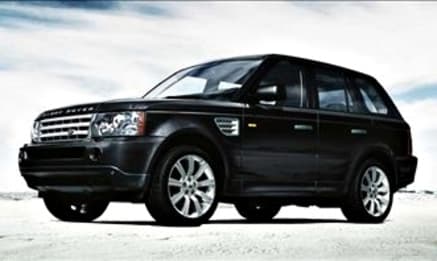
Land Rover Range Rover Sport 2005 review
- Range Rover Sport
- Land Rover Range Rover Sport 2005
- Range Rover Sport Reviews
- Land Rover Reviews
- Land Rover SUV Range
- SUV
- Wagon
- Land Rover
- Prestige & Luxury Cars

For Ford's Premier Automotive Group (PAG) boss Mark Fields that point must have been perilously close in the mountains of the La Vinyetta region, north of Barcelona.
Committing a couple of hundred million dollars to developing a car is one thing, watching your children ride the resulting vehicle up and down a 45-degree rock wall is another thing entirely.
"I had no idea that was going to happen," Fields says of the impromptu – and seriously impressive – display of the new Sport's off-road credentials.
It's as well the Sport performs as it does off-road, not just for the future of the Fields' dynasty but for the wellbeing of the marque.
"The Sport is extremely important for Land Rover," Fields says during the launch of a vehicle tasked with bringing new and younger blood to the quintessential off-road brand.
"It does a couple of things. It broadens the appeal of the Land Rover brand ... obviously we are known for being the best off-road and all the things that go with that but what we have introduced now is the ability to get on-road credentials as well."
With all the recognisable DNA of the Range Rover – albeit in a lower, slightly smaller package – the Sport comes to market with a choice of three engines and a couple of distinct road characters. Entry level for our market will be the 2.7-litre turbo diesel with 140kW and 440Nm, the model Land Rover Australia boss Steve Morten expects to account for about half of the estimated 1000 annual sales. "The diesel will be the volume car and it will be priced to go head-to-head with the (BMW) X5," Morten says.
The car goes on sale in Australia on September 1 – the diesel will likely cost about $85,000. The two petrol engines are Jaguar-sourced V8s, tuned to provide the torque characteristics favoured by off-roaders.
A 4.4-litre naturally aspirated eight which produces 220kW and 425Nm will be priced about $100,000 for Australia.
The hero model, expected to provide about 15 per cent of the mix at a price tag of $135,000, is the 4.2-litre supercharged V8 with 287kW and 550Nm, 80 per cent of which is on tap from just 1500rpm. "The Range Rover Sport will fill that white space between Discovery III and Range Rover," Land Rover marketing manager Finbar McFall says.
"It is designed to compete against X5, Cayenne and Touareg but it is not a copy or a facsimile of any of those vehicles. Rather it is Land Rover's vision of what an on-road SUV should be like."
To give the Sport its on-road abilities Land Rover's engineers have balanced the size and weight of the Sport – it is still a considerable 2572kg in supercharged trim – with an array of technical wizardry. All models come with air suspension and Land Rover's brilliant Terrain Response AWD selector which allows a simple dial-in choice of various conditions from dry roads through to sand, rock and mud. The system then sets optimum ride height, traction, engine, throttle sharpness and differential lock settings.
FIRST DRIVE
The supercharged model offers active anti-roll bars – Dynamic Response in Land Rover speak – as standard while it can be optioned on the other models.
Computer control stiffens and relaxes – to the point of disengaging to allow full wheel articulation over rough ground – the bars to produce a surprisingly taunt and controlled ride through twisting mountain roads.
On the open road the Range Rover Sport is akin to a huge sports car. The supercharged model has unseemly urge with a seemingly singular intent of reaching the horizon as swiftly as possible. In truth, there are plenty of quicker cars with higher terminal speeds on the road. However, few that match its bulk can come anywhere near it for performance.
The naturally aspirated model has a very different character. Still with plenty of power, there is a greater need to utilise the paddle-shift for the six-speed ZF gearbox. Top is for little more than cruising on a slight downslope and any form of acceleration is going to require a visit to third or fourth gear.
Once the revs are up in the active range the Sport gets along with a reasonable degree of urgency. However, gravity has a pretty fair hold on the Sport's 2.5 tonnes and exacts its toll in fuel economy.
Land Rover claims figures of 16l/100km combined but during the launch drive the best return was almost 18l/100km on a high-speed motorway run and as high as 23l/100km on twisting mountain roads.
The interior of the Sport echoes the recently launched Discovery III, both in its style – tasteful wood and leather – and high equipment levels. Space is at a little more of a premium, the roof is lower and rear seat leg room more restricted.
Designers have been mindful that the vast majority of the cars life will be spent jousting in city traffic with much smaller vehicles. The low-mounted bumpers and low-collision load path are designed to minimise damage to smaller vehicles in an accident by making the initial contact at a level where their passive safety systems are most effective.
Pricing guides
Range and Specs
| Vehicle | Specs | Price* | |
|---|---|---|---|
| 4.2 S/C First Edition | 4.2L, PULP, 6 SP SEQ AUTO | $16,500 – 21,120 | 2005 Land Rover Range Rover Sport 2005 4.2 S/C First Edition Pricing and Specs |
| 2.7 TDV6 | 2.7L, Diesel, 6 SP SEQ AUTO | $11,770 – 15,730 | 2005 Land Rover Range Rover Sport 2005 2.7 TDV6 Pricing and Specs |
| 4.2 S/C | 4.2L, PULP, 6 SP SEQ AUTO | $14,630 – 19,250 | 2005 Land Rover Range Rover Sport 2005 4.2 S/C Pricing and Specs |
| 4.4 V8 | 4.4L, PULP, 6 SP SEQ AUTO | $13,420 – 17,600 | 2005 Land Rover Range Rover Sport 2005 4.4 V8 Pricing and Specs |
$14,750
Lowest price, based on 3 car listings in the last 6 months







